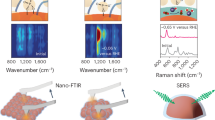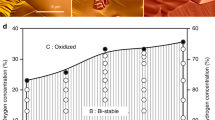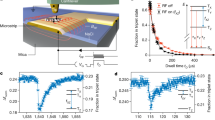Abstract
Manganese porphyrins have been extensively investigated as model systems for the natural enzyme cytochrome P450 and as synthetic oxidation catalysts. Here, we report single-molecule studies of the multistep reaction of manganese porphyrins with molecular oxygen at a solid/liquid interface, using a scanning tunnelling microscope (STM) under environmental control. The high lateral resolution of the STM, in combination with its sensitivity to subtle differences in the electronic properties of molecules, allowed the detection of at least four distinct reaction species. Real-space and real-time imaging of reaction dynamics enabled the observation of active sites, immobile on the experimental timescale. Conversions between the different species could be tuned by the composition of the atmosphere (argon, air or oxygen) and the surface bias voltage. By means of extensive comparison of the results to those obtained by analogous solution-based chemistry, we assigned the observed species to the starting compound, reaction intermediates and products.
This is a preview of subscription content, access via your institution
Access options
Subscribe to this journal
Receive 12 print issues and online access
$259.00 per year
only $21.58 per issue
Buy this article
- Purchase on Springer Link
- Instant access to full article PDF
Prices may be subject to local taxes which are calculated during checkout






Similar content being viewed by others
References
Tabushi, I. Reductive dioxygen activation by use of artificial cytochrome P450 systems. Coord. Chem. Rev. 86, 1–42 (1988).
Feiters, M. C., Rowan, A. E. & Nolte, R. J. M. From simple to supramolecular cytochrome P450 mimics. Chem. Soc. Rev. 29, 375–384 (2000).
Meunier, B. Metalloporphyrins as versatile catalysts for oxidation reactions and oxidative DNA cleavage. Chem. Rev. 92, 1411–1456 (1992).
Mansuy, D. Activation of alkanes – the biomimetic approach. Coord. Chem. Rev. 125, 129–141 (1993).
Groves, J. T. in Cytochrome P450: Structure, Mechanism, and Biochemistry 3rd edn (ed. Ortiz de Montellano, P. R.) 1–43 (Kluwer Academic/Plenum 2005).
Song, W. J. et al. Synthesis, characterization, and reactivities of manganese(V)–oxo porphyrin complexes. J. Am. Chem. Soc. 129, 1268–1277 (2007).
Zhang, R., Horner, J. H. & Newcomb, M. Laser flash photolysis generation and kinetic studies of porphyrin–manganese–oxo intermediates. Rate constants for oxidations effected by porphyrin–Mn–V–oxo species and apparent disproportionation equilibrium constants for porphyrin–Mn–IV–oxo species. J. Am. Chem. Soc. 127, 6573–6582 (2005).
Grim, P. C. M. et al. Submolecularly resolved polymerization of diacetylene molecules on the graphite surface observed with scanning tunneling microscopy. Angew. Chem. Int. Ed. Engl. 36, 2601–2603 (1997).
Hla, S-W., Bartels, L., Meyer, G. & Rieder, K. H. Inducing all steps of a chemical reaction with the scanning tunneling microscope tip: towards single molecule engineering. Phys. Rev. Lett. 85, 2777–2780 (2000).
Okawa, Y. & Aono, M. Nanoscale control of chain polymerization. Nature 409, 683–684 (2001).
Piot, L., Bonifazi, D. & Samorì, P. Organic reactivity in confined spaces under scanning tunneling microscopy control: tailoring the nanoscale world. Adv. Funct. Mater. 17, 3689–3693 (2007).
Grill, L. et al. Nano-architectures by covalent assembly of molecular building blocks. Nature Nanotech. 2, 687–691 (2007).
Turner, M. et al. Deprotection, tethering, and activation of a catalytically active metalloporphyrin to a chemically active metal surface: [SAc](4)P–Mn(III)Cl on Ag(100). J. Am. Chem. Soc. 131, 1910–1914 (2009).
Turner, M. et al. Deprotection, tethering, and activation of a one-legged metalloporphyrin on a chemically active metal surface: NEXAFS, synchrotron XPS, and STM study of [SAc]P–Mn(III)Cl on Ag(100). J. Am. Chem. Soc. 131, 14913–14919 (2009).
Seufert, K., Auwärter, W. & Barth, J. V. Discriminative response of surface-confined metalloporphyrin molecules to carbon and nitrogen monoxide. J. Am. Chem. Soc. 132, 18141 (2010).
Beggan, J. P. et al. Control of the axial coordination of a surface-confined manganese(III) porphyrin complex. Nanotechnology 23, 235606 (2012).
Gopakumar, T. G., Tang, H., Morillo, J. & Berndt, R. Transfer of Cl ligands between adsorbed iron tetraphenylporphyrin molecules. J. Am. Chem. Soc. 134, 11844–11847 (2012).
Hulsken, B. et al. Real-time single-molecule imaging of oxidation catalysis at a liquid–solid interface. Nature Nanotech. 2, 285–289 (2007).
Friesen, B. A., Bhattarai, A., Mazur, U. & Hipps, K. W. Single molecule imaging of oxygenation of cobalt octaethylporphyrin at the solution/solid interface: thermodynamics from microscopy. J. Am. Chem. Soc. 134, 14897–14904 (2012).
Reed, C. A., Kouba, J. K., Grimes, C. J. & Cheung, S. K. Manganese(II) and chromium(II) porphyrin complexes — synthesis and characterization. Inorg. Chem. 17, 2666–2670 (1978).
Creager, S. E., Raybuck, S. A. & Murray, R. W. An efficient electrocatalytic model cytochrome-P-450 epoxidation cycle. J. Am. Chem. Soc. 108, 4225–4227 (1986).
Lyons, J. E., Ellis, P. E. & Myers, H. K. Halogenated metalloporphyrin complexes as catalysts for selective reactions of acyclic alkanes with molecular oxygen. J. Catal. 155, 59–73 (1995).
Jones, R. D., Summerville, D. A. & Basolo, F. Synthetic oxygen carriers related to biological systems. Chem. Rev. 79, 139–179 (1979).
Watanabe, Y. & Fujii, H. Metal–Oxo and Metal–Peroxo Species in Catalytic Oxidations 61–89 (Springer, 2000).
Schardt, B. C., Hollander, F. J. & Hill, C. L. Isolation, purification, and characterization of high-valent complexes from a manganese porphyrin based catalytic hydrocarbon activation system—crystal and molecular-structure of μ-oxo-bis[azido(tetraphenylporphinato)–manganese(IV)]. J. Am. Chem. Soc. 104, 3964–3972 (1982).
Smegal, J. A., Schardt, B. C. & Hill, C. L. Isolation, purification, and characterization of intermediate (iodosylbenzene)metalloporphyrin complexes from the (tetraphenylporphinato)–manganese(III)–iodosylbenzene catalytic hydrocarbon functionalization system. J. Am. Chem. Soc. 105, 3510–3515 (1983).
Nolte, R. J. M., Razenberg, J. A. S. J. & Schuurman, R. On the rate-determining step in the epoxidation of olefins by monooxygenase models. J. Am. Chem. Soc. 108, 2751–2752 (1986).
Van der Made, A. W., Nolte, R. J. M. & Drenth, W. On the mechanism of epoxidation of alkenes with hypochlorite, catalyzed by manganese(III) tetraarylporphyrins. Recl. Trav. Chim. Pays-Bas 109, 537–551 (1990).
Dismukes, G. C., Sheats, J. E. & Smegal, J. A. Mn2+/Mn3+ and Mn3+/Mn4+ mixed-valence binuclear manganese complexes of biological interest. J. Am. Chem. Soc. 109, 7202–7203 (1987).
Linares, M. et al. Chiral expression at the solid–liquid interface: a joint experimental and theoretical study of the self-assembly of chiral porphyrins on graphite. Langmuir 24, 9566–9574 (2008).
Iavicoli, P. et al. Tuning the supramolecular chirality of one- and two-dimensional aggregates with the number of stereogenic centers in the component porphyrins J. Am. Chem. Soc. 132, 9350–9362 (2010).
Hoffman, B. M., Weschler, C. J. & Basolo, F. Dioxygen adduct of meso-tetraphenylporphyrinmanganese(II), a synthetic oxygen carrier. J. Am. Chem. Soc. 98, 5473–5482 (1976).
Hoffman, B. M., Szymanski, T., Brown, T. G. & Basolo, F. Dioxygen adducts of several manganese(II) porphyrins—electron-paramagnetic resonance studies. J. Am. Chem. Soc. 100, 7253–7259 (1978).
Jones, R. D., Summerville, D. A. & Basolo, F. Manganese(II) porphyrin oxygen carriers—equilibrium-constants for reaction of dioxygen with para-substituted meso-tetraphenylporphinatomanganese(II) complexes. J. Am. Chem. Soc. 100, 4416–4424 (1978).
Jones, R. D., Summerville, D. A. & Basolo, F. Synthetic oxygen carriers related to biological systems. Chem. Rev. 79, 139–179 (1979).
Fabris, S. et al. Oxygen dissociation by concerted action of di-iron centers in metal–organic coordination networks at surfaces: modeling non-heme iron enzymes. Nano Lett. 11, 5414–5420 (2011).
Huskens, J. et al. A model for describing the thermodynamics of multivalent host–guest interactions at interfaces. J. Am. Chem. Soc. 126, 6784–6797 (2004).
Miyake, K. et al. Molecular motion of surface-immobilized double-decker phthalocyanine complexes. J. Am. Chem. Soc. 131, 17808–17813 (2009).
Oyaizu, K., Haryono, A., Yonemaru, H. & Tsuchida, E. Catalytic behavior of a μ-oxo dimanganese(III) octaethylporphyrin in O2 reduction. J. Chem. Soc. Faraday Trans. 94, 3393–3399 (1998).
He, Y. & Borguet, E. Dynamics of porphyrin electron-transfer reactions at the electrode–electrolyte interface at the molecular level. Angew. Chem. Int. Ed. 46, 6098–6101 (2007).
Bai, Y. et al. Interfacial coordination interactions studied on cobalt octaethylporphyrin and cobalt tetraphenylporphyrin monolayers on Au(111). Phys. Chem. Chem. Phys. 12, 4336–4344 (2010).
Suárez, S. A. et al. A surface effect allows HNO/NO discrimination by a cobalt porphyrin bound to gold. Inorg. Chem. 49, 6955–6966 (2010).
Hieringer, W. et al. The surface trans effect: influence of axial ligands on the surface chemical bonds of adsorbed metalloporphyrins. J. Am. Chem. Soc. 133, 6206–6222 (2011).
Acknowledgements
NanoNed (the Dutch nanotechnology initiative of the Ministry of Economic Affairs), the Foundation for Fundamental Research on Matter (FOM programme Atomic and Molecular Nanophysics) and the Ministry of Education, Culture and Science (Gravity program 024.001.035) are acknowledged for financial support. D.B.A. acknowledges funding from projects CTQ2010-16339 and 2009 SGR 158. S.D.F. acknowledges support from the Fund of Scientific Research−Flanders (FWO), KU Leuven (GOA) and the Belgian Federal Science Policy Office (IAP-P7/05). J.A.A.W.E. and T.H. thank the Council for the Chemical Sciences of The Netherlands Organisation for Scientific Research (CW-NWO) for a Vidi grant (700.58.423) and an ECHO grant (700.57.023), respectively. J.A.A.W.E. thanks the European Research Council for an ERC Starting Grant (NANOCAT – 259064).
Author information
Authors and Affiliations
Contributions
J.A.A.W.E., S.D.F. and D.B.A. conceived the idea and designed the experiments. D.d.B. and M.L. performed the STM experiments. T.H. and D.d.B. carried out data analyses, and P.I. synthesized and characterized the compound. D.d.B., M.L. and J.A.A.W.E. co-wrote the paper. All authors analysed and discussed the results and commented on the manuscript.
Corresponding authors
Ethics declarations
Competing interests
The authors declare no competing financial interests.
Supplementary information
Supplementary information
Supplementary information (PDF 2469 kb)
Supplementary Movie
Supplementary Movie (AVI 32467 kb)
Rights and permissions
About this article
Cite this article
den Boer, D., Li, M., Habets, T. et al. Detection of different oxidation states of individual manganese porphyrins during their reaction with oxygen at a solid/liquid interface. Nature Chem 5, 621–627 (2013). https://doi.org/10.1038/nchem.1667
Received:
Accepted:
Published:
Issue Date:
DOI: https://doi.org/10.1038/nchem.1667
This article is cited by
-
Small molecule binding to surface-supported single-site transition-metal reaction centres
Nature Communications (2022)
-
Application of Scanning Tunneling Microscopy in Electrocatalysis and Electrochemistry
Electrochemical Energy Reviews (2021)
-
Full use of factors promoting catalytic performance of chitosan supported manganese porphyrin
Scientific Reports (2020)
-
Chirally-Modified Graphite Oxide as Chirality Inducing Support for Asymmetric Epoxidation of Olefins with Grafted Manganese Porphyrin
Catalysis Letters (2020)
-
Biosynthesis of organic photosensitizer Zn-porphyrin by diphtheria toxin repressor (DtxR)-mediated global upregulation of engineered heme biosynthesis pathway in Corynebacterium glutamicum
Scientific Reports (2018)



